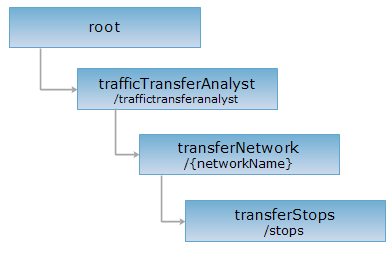URI
<transferNetwork_uri>/stops[.<format>]
Supported methods
Parent resource
Child resources
Introduction
Traffic transfer stop root directory. The stop information can be got by two methods: Stop ID and stop keyword. Only keyword is supported currently.
Supported Methods:
- GET: Return child resource list, mainly used to get stop information by different means.
- HEAD: Checks whether stops resource exists, or whether it can be accessed.
Supported output formats: rjson, json, html, xml.
GIS Services Resource Hierarchy

HTTP request methods
Implement the HTTP request on the following URI, where supermapiserver is the server name, with rjson being the output format.
http://supermapiserver:8090/iserver/services/traffictransferanalyst-sample/restjsr/traffictransferanalyst/Traffic-Changchun/stops.rjson
GET request
The child resource list returned.
Request parameter
None.
Response structure
| Field | Type | Description |
| name | String | The name of the child resources transfer line. |
| path | String | The access path of the child resource. |
| resourceConfigID | String | The configuration item ID of the resource. |
| resourceType | String | The resource type. |
| supportedMediaTypes | String[] | The media-type of the supported representation. |
| visible | boolean | Whether it is visible. |
Respose example
Perform GET request on stop resource, http://supermapiserver:8090/iserver/services/traffictransferanalyst-sample/restjsr/traffictransferanalyst/Traffic-Changchun/stops.rjson the representation in rjson format returned is as the following:
[{
"name": "keyword",
"path": "http://supermapiserver:8090/iserver/services/traffictransferanalyst-sample/restjsr/traffictransferanalyst/Traffic-Changchun/stops/keyword",
"resourceConfigID": null,
"resourceType": null,
"supportedMediaTypes": null,
"visible": true
}]
HEAD request
Asks for the response identical to the one that would correspond to a GET request, but without the response body. This is useful for retrieving meta-information written in response headers, without having to transport the entire content. The meta-information includes the media-type, content-encoding, transfer-encoding, content-length, etc.
HEAD request can be used to check if the stops resource exists, or if the resource can be accessed by clients. It can also determine if the stops resource supports an output format <format> if performed on a URI with .<format> included.